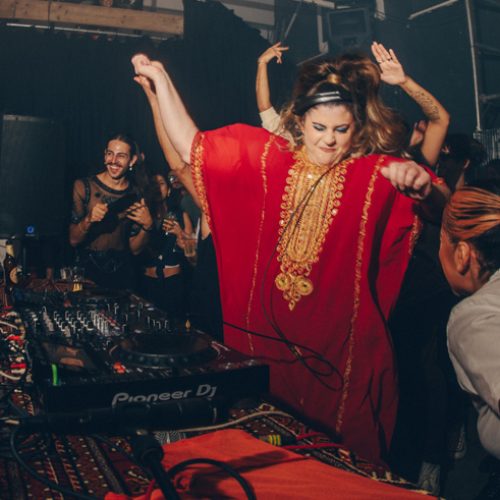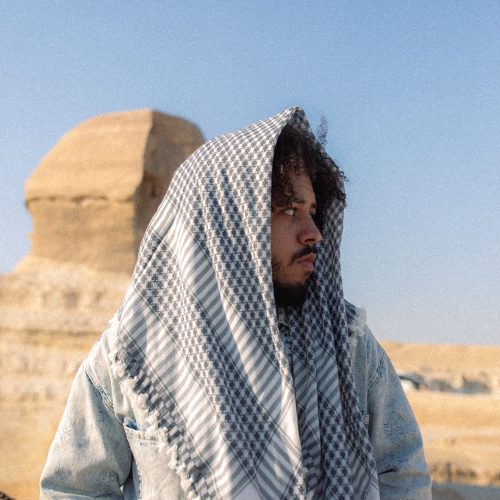Situated in downtown Cairo, the room was dimly lit, and filled with a rich scent of bakhoor. The wooden chairs scattered across the space each held an audience member sitting down in anticipation for the ancient ritual to commence. The sheikha appears in a traditional Egyptian galabeya adorned in intricate gold patterns, thick kohl around her eyes, black-stained lips, silver jewelry, and a charm that is hard to forget. Sat behind her was her male and female ensemble, also dressed in distinctive traditional wear, each holding a percussive instrument of their own— from finger cymbals, tambourines, to various drums, a woodwind, and an interesting instrument that resembled the sound of maracas, but was tied around the waist with an array of beads. The drums slowly start to set the tempo of the traditional sway, all of them moving in unison, the pounding begins to escalate, and the sheikha continues to move in a trance-like routine whilst saying certain duaa’s. Alast, The Zar begins— dancing the night away into a spiritual realm.
Zar is a tradition that dates all the way back to the eighteenth century in central Ethiopia and that eventually spread to the Red Sea and the Arabian Gulf through the nineteenth century slave trade. Throughout Egyptian history zar has incorporated elements from popular Islamic Sufi practices.

If a person is suspected to have been possessed by an evil spirit or in other words jinn, that’s when a haflet zar comes into play. The person suspected is taken to a zar leader referred to as a sheikh or sheikha, who is usually a woman, who performs a ritual diagnosis, during which contact with the spirit world is established. The diagnosis either confirms or denies whether the victim is truly possessed, and if so, the festivities commence, as stated in Liminal Rites and Female Symbolism in the Egyptian Zar Possession Cult by Richard Natvig.
Traditionally, the victim is accustomed to sacrifice animals for the spirit of the possessed person. However, this tradition has changed in favor of a more public ritual that involves music and dance. The ceremony sees a tasteful visual and listening experience as the woman leading it is dressed in special clothes, ornaments, amulets, which according to Natvig, is decided by the spirit in question in order to maintain a new relationship with the entity. The ritual is divided into three parts– a beginning, middle, and end. The sheikha starts by saying verses of the Quran, and saying certain duaas, as the ceremony starts to escalate gradually. Situating the victim in the middle, whilst the sheikha and her ensemble rotate around them. The victim screams and cries, and the spirit is expelled from his/her body. The sheikha’s movements begin to slow down, and the spirit is gone.

It is important to point out the imperative role women play in this ritual, as the tradition has opened a safe space, as a form of relief to women in strict patriarchal societies. Essentially, making it a place where the women in practice are given a place to take out all their concerns, giving them a form of solace making it a cathartic experience.
This practice was commonly spread throughout Egypt, but this has changed. Many people believed it was a cult-practice, with the Egyptian government condemning it to be illegal in the early 20th century, according to the Egyptian Streets. However, the tradition continues to be performed especially in the southern region of the country.

Mazaher, are the female-led group shedding a light on the traditional ritual, essentially reviving it and keeping it alive. Composed of three female musicians, Umm Hassan, Umm Sameh, Nour El Sabah, and additional instrumentalists— they are among the last remaining Zar practitioners in Egypt. The group quickly rose to popularity in the North African country over the years, with many people flocking to see them perform in an ethereal manner in Downtown Cairo’s cultural center, Makan.
Nonetheless, what started off as a form of exorcism, the ancient ritual lives on today taking on many forms. A culturally tasteful, sometimes therapeutic, and most importantly a place where women can spiritually expel the wrong-doings and hardships that have possessed their lives, zar is an undeniably cathartic experience for both the sheikha and the audience.









